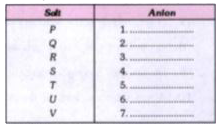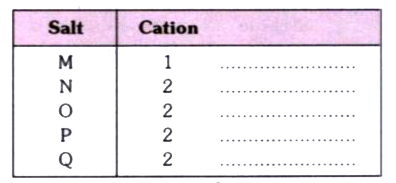An alcoholic solution of dimethylglyoxime is added to an aqueous solution of nickel(II) chloride.Slow addition of ammonium hydroxide led to the precipitation of a bright-red coloured metal complex.
Find out the number of hydrogen bonds present in the structure of the complex.
The correct Answer is:2
To solve the question regarding the number of hydrogen bonds in the complex formed by dimethylglyoxime and nickel(II) chloride, we can follow these steps:
1. Identify the Reactants:
- We start with an alcoholic solution of dimethylglyoxime (C4H8N2O2) and an aqueous solution of nickel(II) chloride (NiCl2).
2. Understand the Reaction:
- When dimethylglyoxime is added to nickel(II) chloride, a coordination complex is formed. The reaction involves the formation of a bright-red colored complex due to the coordination of dimethylglyoxime with nickel ions.
3. Write the Reaction Equation:
- The reaction can be represented as:
\(
\text{NiCl}_2 + \text{dimethylglyoxime} \rightarrow \text{(Ni(dimethylglyoxime))}^{2+} + 2\text{Cl}^-
\)
4. Draw the Structure of the Complex:
- The structure of the nickel-dimethylglyoxime complex can be represented as:
CH3C(=O)C(=O)N(CH3)NiN(CH3)C(=O)C(=O)CH3
- In this structure, dimethylglyoxime acts as a bidentate ligand, coordinating through its two nitrogen atoms.
5. Identify Hydrogen Bonding Sites:
- In the structure of the complex, look for potential hydrogen bond donors and acceptors. The oxygen atoms in the dimethylglyoxime can act as hydrogen bond acceptors, while the hydrogen atoms attached to these oxygen atoms can act as hydrogen bond donors.
6. Count the Hydrogen Bonds:
- Each oxygen atom in the dimethylglyoxime can form a hydrogen bond with a hydrogen atom. In the structure, there are two oxygen atoms that can participate in hydrogen bonding, leading to a total of 2 hydrogen bonds.
7. Conclusion:
- Therefore, the number of hydrogen bonds present in the structure of the complex is 2.
- We start with an alcoholic solution of dimethylglyoxime (C4H8N2O2) and an aqueous solution of nickel(II) chloride (NiCl2).
- When dimethylglyoxime is added to nickel(II) chloride, a coordination complex is formed. The reaction involves the formation of a bright-red colored complex due to the coordination of dimethylglyoxime with nickel ions.
- The reaction can be represented as:
\(
\text{NiCl}_2 + \text{dimethylglyoxime} \rightarrow \text{(Ni(dimethylglyoxime))}^{2+} + 2\text{Cl}^-
\)
- The structure of the nickel-dimethylglyoxime complex can be represented as:
CH3C(=O)C(=O)N(CH3)NiN(CH3)C(=O)C(=O)CH3
- In this structure, dimethylglyoxime acts as a bidentate ligand, coordinating through its two nitrogen atoms.
- In the structure of the complex, look for potential hydrogen bond donors and acceptors. The oxygen atoms in the dimethylglyoxime can act as hydrogen bond acceptors, while the hydrogen atoms attached to these oxygen atoms can act as hydrogen bond donors.
- Each oxygen atom in the dimethylglyoxime can form a hydrogen bond with a hydrogen atom. In the structure, there are two oxygen atoms that can participate in hydrogen bonding, leading to a total of 2 hydrogen bonds.
- Therefore, the number of hydrogen bonds present in the structure of the complex is 2.
Topper's Solved these Questions
- BOOK - RESONANCE ENGLISHCHAPTER - QUALITATIVE ANALYSIS PART 1EXERCISE - EXERCISE 322videos
QUALITATIVE ANALYSIS PART 1
- BOOK - RESONANCE ENGLISHCHAPTER - QUALITATIVE ANALYSIS (ANION)EXERCISE - Matching List Type1videos
QUALITATIVE ANALYSIS (ANION)
- BOOK - RESONANCE ENGLISHCHAPTER - RANK BOOSTEREXERCISE - All Questions1896videos
RANK BOOSTER
Similar Questions
Find out the number of hydrogen bonds present in the structure of the nickel dimethylglyoxime complex .
View SolutionWhen diemethyl glyoxime is added to the aqueous solution of nickel (II) chloride in presence of dilute ammonia solution, a bright red coloured precipitate is obtained .
(a) Draw the structure of bright red substance .
(b) Write the oxidation state of nickel in the substance and hybridisation.
(c ) State whether the substance is paramagnetic or diamagnetic.View SolutionAqueous solution of CoCl3⋅6NH3 upon addition with AgNO3 produces 3 moles white precipitate . Primary and secondary valency of metal in this complex is
View SolutionSalts P, Q,R,S,T,U and V undergo reactions (i) to (vii) respectively. Identify the cation present in these salts on the basis of these reactions. Tabulate your answer in the formate given below.
(i) When the salt Pis heated with sodium hydroxide solution a vigorous reaction takes place and a colourless gas is evolved with a pungent and suffocating smell that brings tears in our eyes. The evolved gas gives dense white fumes with a moist glass rod depped with hydrochloric acid.
(ii) Addition of sodium hydroxide solution to a solution of salt Q gives a thick white precipitae which is soluble in excess of sodium hydroxide solution to form a clear solution.
(iii) Addition of ammonium hydroxide solution to a solution of salt R gives a dark blue precipitate which is soluble is excess of ammonium hydroxide solution to form an intense deep blue solution.
(iv) Addition of ammonium hydroxide solution to a solution of 5 gives a dirty green [bottle green] precipitate which is insoluble even in the excess of ammonium hydroxide solution.
(v) Addition of ammonium hydroxide solution to a solution of T gives a reddish brown (rust precipitate] precipitate which is insoluble even in the excess of ammonium hydroxide solution.
(vi) Addition of ammonium hydroxide solution to a solution of V gives a geletaneous white precipitate which is soluble in excess of ammonium hydroxide solution to form a clear solution.
(vii) Addition of ammonium hydroxide solution to a solution of V gives no precipitate but it gives a chalky white precipitate with sodium hydroxide solution which is insoluble even in the excess of sodium hydroxide solution.
 View Solution
View SolutionNickel chloride, when treated with dimethyl gyloxime in presence of ammonium hydroxide, a bright red precipitate is obtained. Answer the following:
(a) Draw the structure of the complex showing H-bonds
(b) Give oxidation state of nickel and its hybridization
(c) Predict the magnetic behaviour of the complexView SolutionSalts M, N, O, P and Q undergo reactiom (i) to (v) respectively.
Identify the cation present in these salts on the basis of these reaction. Tabulate your answer in the format given below.
1. When sodium hydroxide solution is added to the salt M, and heated strongly a colourless gas with a pungent smell is evolved which turm red litmus paper blue and gives dense white fumes with a moist glass rod with hydrochloric acid.
2. Addition of dilute hydrochloric acid to a solution of N gives a thick white precipitate which is soluble in hot water.
3. When ammonium hydroxide solution is added to the solution of 0 a light blue precipitate is obtained which is soluble in excess of ammonium hydroxide to form an inteme deep blue solution.
4. When ammonium hydroxide solution is added to the solution of P reddish brown (mustard colour) precipitate is obtained which ,is insoluble even in the excess of ammonium hydroxide solution.
5. When sodium hydroxide solution is added to the solution of Q a which coloured gelatinous precipitate is obtained which is soluble in excess of sodium hydroxide to form a clear solution
 View Solution
View Solutionp-Amino-N,N-dimethylaniline is added to a strongly acidic solution of X. The resulting solution is treated with a few drops of aqueous solution of Y to yield blue colouration due to the formation of methylene blue. Treatment of aqueous solution of Y with reagent potassium hexacyanoferrate (II) leads to the formation of an intense blue precipitate. The precipitate dissolves on excess addition of the reagent. Similarly, the treatment of the solution of Y with the solution of potassium hexacyanoferrate (III) leads to a brown colouration due to the formation of Z.
Q. Compound X isView Solutionp-Amino-N,N-dimethylaniline is added to a strongly acidic solution of X. The resulting solution is treated with a few drops of aqueous solution of Y to yield blue colouration due to the formation of methylene blue. Treatment of aqueous solution of Y with reagent potassium hexacyanoferrate (II) leads to the formation of an intense blue precipitate. The precipitate dissolves on excess addition of the reagent. Similarly, the treatment of the solution of Y with the solution of potassium hexacyanoferrate (III) leads to a brown colouration due to the formation of Z.
Q. Compound Y isView Solutionp-Amino-N,N-dimethylaniline is added to a strongly acidic solution of X. The resulting solution is treated with a few drops of aqueous solution of Y to yield blue colouration due to the formation of methylene blue. Treatment of aqueous solution of Y with reagent potassium hexacyanoferrate (II) leads to the formation of an intense blue precipitate. The precipitate dissolves on excess addition of the reagent. Similarly, the treatment of the solution of Y with the solution of potassium hexacyanoferrate (III) leads to a brown colouration due to the formation of Z.
Q. Compound Z isView SolutionThe addition of ammonium chloride to a solution containing ferric and magnesium ions is essential for selective precipitation of ferric hydroxide by aqueous ammonia.
View Solution

